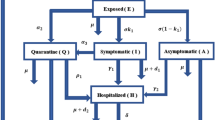Abstract
In this study, the aim is to formulate a multi-compartment mathematical model regarding the transmission and dynamics of HIV–AIDS. The model is formulated on the basis of a system of linear, ordinary differential equations and admits two locally and globally stable equilibria. Primarily, the existence of the solution of the model and its uniqueness are demonstrated which is then obtained analytically using the fundamental matrix method and eigenvalue approach. The obtained solution serves as the pedestal for studying the dynamics and spread of HIV–AIDS in India. Nevertheless, as an endorsement to the obtained results the simulations are also carried out with model outcomes being contrasted to the exact data of the disease in India.




Similar content being viewed by others
References
Abueldahab SME, Mutombo FK (2021) SIR model and HIV/AIDS in Khartoum. Open Access Lib J 8:1–10
Akbulut A, Sajjad Hashemi M, Rezazadeh H (2021) New conservation laws and exact solutions of coupled Burgers’ equation. Waves Random Complex Med 2:1–20
Benaicha S, Bouteraa N (2017) Existence of solutions for three-point boundary value problem for nonlinear fractional differential equations. Bull Transilv Univ Brasov Math Inform Phys Ser 10(2):31–48
Bouteraa N, Inc M, Hashemi MS, Benaicha S (2022) Study on the existence and nonexistence of solutions for a class of nonlinear Erdèlyi–Kober type fractional differential equation on unbounded domain. J Geom Phys 33:104546
Diallo O, Konè Y, Pousin J (2012) A model of spatial spread of an infection with applications to HIV/AIDS in Mali. Appl Math 3(12):1877–81
Dutta A, Gupta PK (2022) Stability analysis of HIV/AIDS dynamics: modelling the tested and untested populations. Pramana J Phys 96:42. https://doi.org/10.1007/s12043-021-02288-6
Faniran TS, Adewole MO, Ahmad H, Abdullah FA (2022) Dynamics of tuberculosis in HIV–HCV co-infected cases. Int J Biomath 215:2250091
Fioranelli M, Ahmad H, Sepehri A, Roccia MG, Aziz F (2022) A mathematical model for imaging and killing cancer cells by using concepts of the Warburg effect in designing a graphene system. Math Biosci Eng 19(3):2985–2995
Gupta PK, Dutta A (2019) A mathematical model on HIV/AIDS with fusion effect: analysis and homotopy solution. Eur Phys J Plus 134:265. https://doi.org/10.1140/epjp/i2019-12599-8
Haq IU, Ali N, Ahmad H, Nofal TA (2022) On the fractional-order mathematical model of COVID-19 with the effects of multiple non-pharmaceutical intervention. AIMS Math 7(9):16017–16036
Hartman P (2010) Ordinary differential equations. Class Appl Math 38(2):1106
Hashemi MS, Inc M, Yusuf A (2020) On three-dimensional variable order time fractional chaotic system with nonsingular kernel. Chaos, Solitons Fractals 133:109628
Hashemi MS, Partohaghighi M, Ahmad H (2022) New mathematical modellings of the human liver and hearing loss systems with fractional derivatives. Int J Biomath 51:3601
Huang D et al (2016) Analysis of an HIV infection model with treatments and delayed immune response. Appl Math Model 40:3081
Huo HF, Feng LX (2013) Global stability for an HIV/AIDS epidemic model with different latent stages and treatment. Appl Math Model 37(3):1480–9
Huo H, Chen R, Wang X (2016) Modelling and stability of HIV/AIDS epidemic model with treatment. Appl Math Model 40:6550
Huo HF, Chen R, Wang XY (2016) Modelling and stability of HIV/AIDS epidemic model with treatment. Appl Math Model 40(13–14):6550–9
Indian HIV–AIDS Estimates 2019 Report (2020) National AIDS Control Organization | ICMR—National Institute of Medical Statistics Ministry of Health and Family Welfare, Government of India
Jun-jie W et al (2010) Dynamic mathematical models of HIV/AIDS transmission in China. Chin Med J (Engl) 123(15):2120–2127
Khanday MA (2016) Introduction to modeling and biomathematics. Dilpreet Publishing House, New Delhi
Mbah G, Omale D, Adejo B (2014) A SIR epidemic model for HIV/AIDS infection. IJSER 5(9):1542
Mubarak S et al (2021) An analytical approach to study the drug diffusion through transdermal drug delivery system. Appl Math E-Notes 21:198–208
Mukandavire Z et al (2008) Mathematical analysis of a sex-structured HIV/AIDS model with a discrete time delay. Nonlinear Anal 71:1082
Naresh R, Tripathi A, Sharma D (2009) Modelling and analysis of the spread of AIDS epidemic with immigration of HIV infectives. Math Comput Model 49:880–892
Ross SL (2014) Differential equations, 3rd edn. Wiley, Hoboken
Waziri AS, Massawe ES, Makinde OD (2012) Mathematical modelling of HIV/AIDS dynamics with treatment and vertical transmission. Appl Math 2(3):77–89
Yusuf TT, Benyah F (2012) Optimal strategy for controlling the spread of HIV/AIDS disease: a case study of South Africa. J Biol Dyn 6(2):475–94
Funding
The authors have not disclosed any funding.
Author information
Authors and Affiliations
Corresponding author
Ethics declarations
Conflict of interest
The authors have not disclosed any conflict of interest.
Appendix
Appendix
Consider the following system of n non homogeneous linear differential equations in the matrix form
such that X(t) is an \(n\times 1\) column matrix (to be determined), B(t) is also an \(n\times 1\) column matrix and A is the coefficient square matrix of order n. If \(\lambda _{1}\), \(\lambda _{2}\),...,\(\lambda _{n}\) denote the eigenvalues of A and \(v_{1}\), \(v_{2}\),...,\(v_{n}\) represent the respective corresponding eigenvectors, then the square matrix F(t) of order n, given as
is called the fundamental matrix corresponding to the homogeneous part \(\dfrac{\text {d}}{\text {d}t} X(t)=AX(t)\). Clearly, the matrix F(t) is invertible for all values of t (Ross 2014).
Rights and permissions
Springer Nature or its licensor (e.g. a society or other partner) holds exclusive rights to this article under a publishing agreement with the author(s) or other rightsholder(s); author self-archiving of the accepted manuscript version of this article is solely governed by the terms of such publishing agreement and applicable law.
About this article
Cite this article
Bhat, A.MU.D., Bhat, Y.A. A Multi-compartment Mathematical Model for HIV–AIDS Transmission and Dynamics. Iran J Sci 47, 427–434 (2023). https://doi.org/10.1007/s40995-022-01397-0
Received:
Accepted:
Published:
Issue Date:
DOI: https://doi.org/10.1007/s40995-022-01397-0




